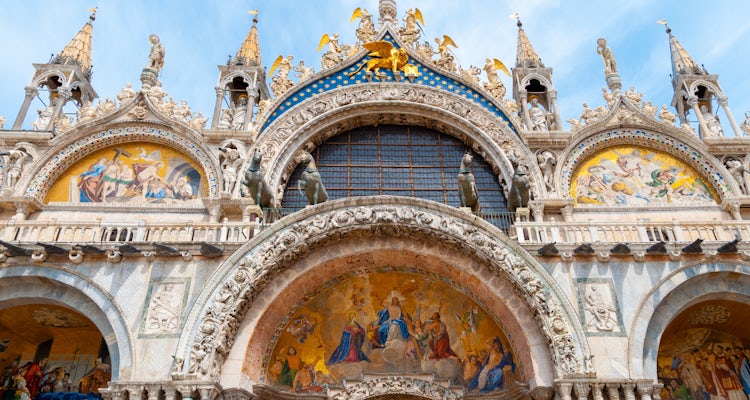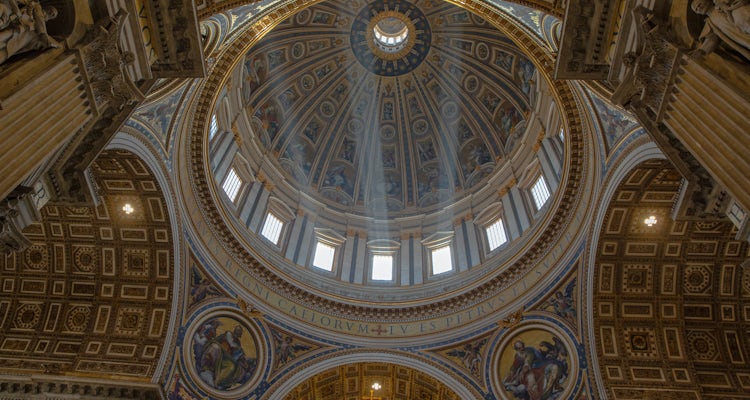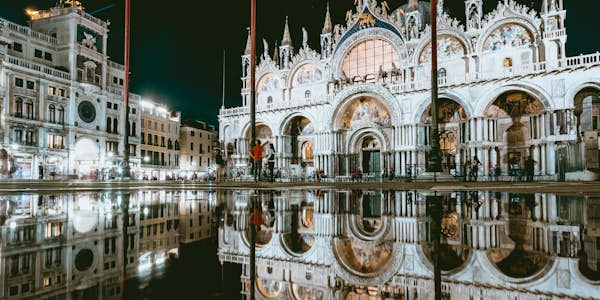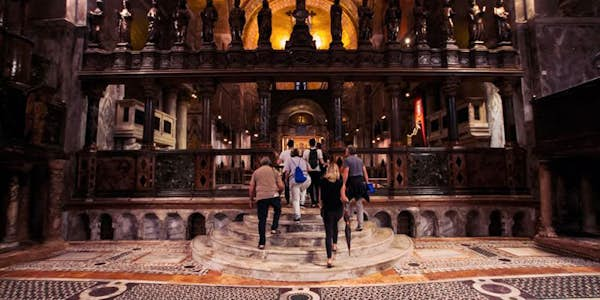St. Mark’s Basilica, one of Venice's most-visited sights and one amongst Italy's top cathedrals is an absolute must-see once you step foot in Venice! With a history that stretches way back to the 9th century A.D., it is a church veiled in rich biblical history and fascinating lores and legends. Ranked one amongst the Top 3 things to do in Venice by Tripadvisor, the St. Mark's Basilica, houses the mortals remains of St. Mark and is considered the world's finest blend of Byzantine, Romanesque, and Gothic architecture.
Recommended St. Mark's Basilica Tickets
Basilica di San Marco is the truest embodiment of the Venetian aesthetics. Known for its opulent design and gilded mosaics it is fondly called "Chiesa d'Oro" which translates to "Church of Gold". It was originally the chapel of the Doge’s until the remains of St. Mark was brought from Alexandria to Venice in 829 and housed here. This ecclesiastical structure was built to house and honour the remains of St. Mark and holds precious artworks, relics and astounding ornamentation. It is an ideal spot for history-lovers, artists, pilgrims and tourists alike. Here are the top recommended St. Mark's Basilica tickets for a memorable visit.
How To Skip the Lines at St. Mark's Basilica
The lines outside San Marco Basilica can be anything between 20 minutes to an hour depending on the time of the day and season (April to October is peak season). If there is a high tide, the St Mark's Square gets flooded and it is highly uncomfortable standing in queues during this period. If you have a child with you, this can be an absolute nightmare
Though the entry to St Mark's Basilica is free, select parts of the Basilica have a distinct fee. The Basilica is divided into 4 parts- Saint Mark's museum, Pala d'Oro, the Bell Tower, and the Treasury. Each of these parts have a seperate entry fee and for each of them you are required to queue up. The ticket prices for each part is enlisted below.
Basilica - Free
Museum - 5.00€
Pala d’Oro - 2.00€
Treasury - 3.00€
Campanile - 8.00€
Now, imagine queueing up every 15 minutes to see parts of one single sight. It is cumbersome and kills your experience. Hence, we strongly recommend purchasing a ticket online which gives you access to all parts of the Basilica via a single ticket. This will save you time, energy and ensure that you spend more time discovering the Basilica than on queues.
Skip the Line + Guided Tour ticket
An economically priced ticket giving you skip-the-line access alog with a guided tour of the Basilica. This ticket allows you to walk past the elongated queue with your certified guide. Walk the length of this Basilica and view masterpieces of Byzantine art with your dedicated tour guide narrating interesting legends and detailing its the rich history. Visit all parts of the museum except the Bell Tower with this ticket. After the Basilica visit, hop onto a private boat and tour the Island of Murano renowned for its long tradition of glass-making and enjoy the complimentary glassblowing tour while you're here.
Check out our Skip the line + Guided Tour ticket for St. Mark's Basilica.
History of St. Mark's Basilica

The story of St Mark's Basilica is a rather interesting one. In 828 AD, 2 merchants from Venice set off to Alexandria for business. In Alexandria, they visited the St. Mark’s sanctuary which held the Saint’s body since his death. While they were here, they happened to speak to the custodians of the sanctuary who told them that the governor of Alexandria was planning to demolish the St. Mark’s sanctuary. This compelled the merchants to ‘save’ St. Mark’s body and rescue it to Venice. They cleverly hid the body in wicker baskets under pork meat and Alexandria being an Islamic state considered pork haram. Hence, the officials at the port did not bother to inspect the goods and waved them through.
Though they swayed past the guards, they faced quite a turmoil at sea. However, they came out of the storm safe and accredited that to St. Mark himself.
When they finally reached Venice with the stolen relic, it was temporarily housed in a chapel within the Doge’s Palace for the first 2 years. In 832, a grand basilica was built close to the Doge’s Palace to shelter the relic , however this basilica burnt down in 976 during an uprising. It was restored by Doge Domenico Cantarini to its present glory by 1071 and till date it has stayed the same; a magnificent grandeur
Watch out for the Mosaic of Porta di Sant'Alipio. It is the only surviving 13th century mosaic on the basilica's exterior and illustrates the above story
St. Mark's Basilica Architecture
North and South Façade
The South Facade facing the water was enclosed until 1503 as it was intended to be used only as a ceremonial purposes. It is adorned with mosaics and sculptures making it an arresting sight from the Grand Canal. You can see the 13th century Byzantine architecture mosaic of Virgin Mary between the 2 griffins in the first arch here. On this facet of the Basilica, you can see the Tetrarchs, a 4th century statue of red granite with 4 co-emperors of the Roman Empire. This was brought to Venice from Constantinople. The North Facade faces the Piazzetta Dei Leoncini and is decorated with the Door of Flowers , also known as the Porta dei Fiori. This Door of Flowers is framed by angels, foliage and prophets and is absolutely gorgeous. You can lay your eyes on a painting of Alexander the Great’s chariot and a 8th century depiction of carved nativity of Mary, Joseph, and two oxen protectively looking over the baby Jesus. You will also see a depiction of with 12 lambs ( respresenting the 12 Apostles) on each side on the facade.
Exterior
The main entrance of the St Mark’s Basilica is from its western facade and if you happen to enter from here, the ornamental exterior will grapple your attention. From outside, you get an overview of the marble columns, domes and gold gilded carvings. The marble columns stand tall in many hues and patterns and decorate all 4 facades of the Basilica. The Central Portal of the Basilica comprises 3 arches which depicts the evolution of the Basilica’s architecture over centuries. The innermost arch has reliefs of foliage depicting the Byzantine era. The middle arch illustrated allegories of months and virtues which shows the Gothic and Romanesque architectural era. The last and outermost arch represents Venice’s Guilds The inner arch is Byzantine and depicts reliefs of flora and fauna. The Gothic and Romanesque middle arch shows allegories of the months and virtues. And the outermost arch is carved with representations of each of Venice's guilds. The mosaic of The Last Judgement is on the outermost arch and depicts a colourful illustration of it.

Interior
Designed in the shape of a Greek Cross, the Basilica has splendid marble inlays on the floor arranged in a geometric pattern along with animal designs. It sheathes 8000 sq.m of gilded mosaics over its walls and ceilings. It is said that this much mosaic is enough to cover over 1 and a half American football fields! The atrium is decorated with mosaic illustrations of the Bible and you will see stories involving Virgin Mary, St. Mark, St. Clement, St. Peter and St. John. The Basilica is held in place with over 500 columns and capitals, most of them Byzantine dating way back to the 6th century.
Dome
St Mark’s Basilica has 5 cupolas, all erected at the intersection over the arms of the Greek Cross structure. They cover an area of 4240 sq.m, each dome being 13 m in diameteres with 16 windows each. These cupolas are decked with gracious amounts of golden mosaic hence giving rise to the name Basilica d'Oro, which translates to Golden Basilica. Majority of these mosaics date back to 1160s, the oldest one above the choir. Each dome depicts specific scenarios - The Creation ( in the Narthex), The Pentecost ( the Western dome), The Ascension (Central Dome), The Life of Saint John (Northern dome) and The Life of Saint Leonard, Saint Nicholas, Clement and Blaise (Southern Dome). The best place to view these domes are from the galleries near the museum.

Transept Chapels
On the arms of the dome, there are a few chapels dedicated to various saints, each more beautiful than the other. Some of the noteworthy ones are Cappella della Madonna dei Máscoli, built in the 15 century comprising of a Gothic altar sculpture and mosaic inlays. Cappella di Sant'Isidoro is adorned with 14th century mosaics and has a sculpted stone coffin with a saint’s remains embedded into the wall. Cappella della Madonna Nicopeia flaunts the priceless Byzantine icon of the Madonna Nicopeia, studded with precious stones in a delicate enamel frame. Cappella di San Clemente was the former Doge's chapel featuring 12th century mosaics. There are just a few of the many over there. As and when you go for a guided tour, you will learn more about the chapels in the Basilica.
What to see inside St. Mark's Basilica?

Pala d'Oro
Pala d’Oro which translates to "Golden Pall" or "Golden Cloth" is a fine piece of Byzantine art studded with a total of 1927 precious gems comprising 526 pearls, 330 garnets, 320 emeralds, 255 sapphires, 183 amethysts, 175 agates, 75 rubies, 34 topazes, 16 carnelians, 13 jaspers along with gold, silver and cloisonne enamel plaques. This jewel encrusted altarpiece depicts the life of Christ and took 366 years to be fabricated to its current glory. If you opt for a free entry to the St. Mark's Basilica, you will have to purchase a seperate ticket to see the Pala d'Oro. If you'd like to experience San Marco Basilica seamlessly, you could purchase a Priority Access Guided Tour ticket to St Mark's Basilica that will allow you to walk into any part of the Basilica carefree.
Museo di San Marco
From the porch of the Basilica, make your way up the flight of stairs to reach Museo di San Marco, the St. Mark’s museum. It flaunts an incredible collection of liturgies, Persian carpets, broken fragments of mosaics( Look out for Tree of Jesse), golden tesserae, 78 bones of different Saints and many other relics. If you walk a little further you will reach the Sala dei Banchetti room showcasing fabrics and the Doge’s red velvet throne. The most important treasure in Museo di San Marco is the Quadriga, the four gilded bronze horses, often called the Horses of San Marco. Lore goes that these horses were stolen from Constantinople in 1204 and displayed on the Loggia terrace for Venetians to feast their eyes. After walking through the museum, take a few minutes to oversee the St Mark's Square from the Loggia. Best view in the city guaranteed! Gaining access to the museum too involves an extra fee, hence booking a comprehensive tour is highly recommended.

Treasury
The Treasury harbours a collection of precious objects looted by the Venetians from Constantinople in 1204 along with a few pieces of art by ancient Venetian craftsmen. These series of rooms are the richest and most important parts of the Basilica and showcase 283 pieces in gold and silver along with a lot many other interesting curios. A few things you ought to lookout for are the crystal fish shaped lamps, cloisonne gold and silver box with pieces of the True Cross, amphorae carved from a single block of agate, alabaster vases from Egypt 300 BC, a perfume-brazier in the form of a small building with five cupolas, the throne of Doge Pietro ,Orseolo, St. George’s reliquary, a Byzantine icon of Archangel Michael and a collection of medieval chalices of precious stones such as sardonyx, turquoise, enamel and chalcedony. This part of the Basilica requires a seperate ticket too. To avoid standing in a queue to see the Treasury, you can pick up your tickets from Headout.
Marble Inlays
The Basilica’s floor is quite literally flooded with marble designed in geometric patterns. These marble inlays cover over 2099 sq.m in hues of earth tones occasionally interspersed with animal and floral designs apart from the geometrical patterns. You will find tiny glints of glass in between these marble inlays. Try spotting designs of foxes, peacocks, doves, roosters and rhinoceros while you’re walking around the Basilica. A good task to put the kids onto while you soak in the history of the Basilica.

Tomb of St. Mark
The crypt which encases St. Mark’s body is a part of the Basilica that is open for tours beyond the usual opening hours. It is believed that the crypt is a part of the original church built to keep safe St. Mark’s corpse after it was brought from Alexandria. The new Basilica was commissioned to be built above the previous building and hence the burial ground transformed into a crypt which is now a much coveted site for visit. The crypt is adorned with mosaics illuminated by dim lighting and the walls of the crypt are eroded due to years of flooding. The crypt is still in use as a burial ground for the Patriarchs of Venice. To indulge in a crypt visit, you will have to book an evening guided tour and walk into this intimate area with a guide who will detail the story of the evangelist relic.
Know Before You Go
Getting to St. Mark's Basilica
Basilica San Marco is bang in the heart of Venice's main sqare Piazza San Marco, also known as Saint Mark's Square. It is easily accessible by all foot and waterways.
Reaching St. Mark's Basilica by Public Vaporetto
If you are taking line #1 and get off at “San Marco Vallaresso”. If you are taking line #2 and get off at “San Marco Giardinetti”. After you alight, walk to Saint Mark’s Square. Once here, look for the Bell Tower and adjcent to it you will find St. Mark's Basilica
Reaching St. Mark's Basilica Private Watertaxi
Ask the driver to take you to the “Todaro” landing stage. Once you alight, walk to Saint Mark’s Square. Once here, look for the Bell Tower and adjcent to it you will find St. Mark's Basilica
Reaching St. Mark's Basilica on Foot
Reaching the St. Mark's Square is fairly easy. Look for the tall Bell Tower once you are here and adjacent to that you will find the St Mark's Basilica.
St. Mark's Basilica Timings
- Mondays-Saturdays 9:45 AM - 5:00 PM
- Sundays and holidays 2:00 PM - 4:00 PM
- Please note that during the months of March, April and days of festivals, the Church remains open until 5:00 pm on Sundays. Monday through Saturday, the opening hours remain the same)
Mass Schedule at St. Mark's Basilica
St. Mark Basilica Weekly Mass Timings
Monday-Friday-
Porta dei Fiori: 7:00 a.m.-7:30 p.m.
Saturdays, Sundays and holidays -
Porta dei Fiori: 7:00 a.m.-7:45 p.m.
St. Mark's Basilica Daily Mass Timings
7:00 am
8:00 am
9:00 am - (Sung Mass of the Charter of the Canons preceded by the celebration of the praises)
10:00 am - ( In Baptistery).
10:30 am - (Sung Mass with brief remarks in various languages, St. Mark’s Chapel)
11:00 am
12:00 - Sundays only (suspended in the months of July and August)
5:30pm - Sundays Only (Celebration of Vespers and Madonna Nicopeia procession with the chant of the litanies)
6:45 pm - (preceded by the celebration of Vespers and the rosary) This mass is often sung by foreign choirs passing through Venice.
Self guided route to explore St. Mark's Basilica
Before entering the Basilica, spend some time outside St. Mark's Basilica looking at the ornamental exteriors and mosaic stories adorning the Basilica. Once you enter the atrium, take the flight of steps to the the Loggia where you will see the Museo di San Marco (San Marco Museum first. After exploring the museum, stand on the terrace outside the museum and enjoy an aerial view of St. Mark's Square. Walk down and explore the domes and chapels of the Basilica, notice the mosaic gilded floors. Next, make your way to the Treasury, followed by the Pala d'Oro and sarcophagus of St. Mark. After you finish seeing all these parts of Basilica, make your way out through the Northern Facade.
Insider Tips
- Dress modestly while visiting the St. Mark’s Basilica. Being a house of worship, those in shorts and tank tops will be denied entrance.
- Avoid carrying bags and large tote bags. You will not be allowed in with these bags and the line to deposit bags in a locker tend to be pretty long.
- Bring binoculars if you own them. You won’t be allowed to click photos in there, so might as well make use of binoculars to see the details and imprint them in your memory.
- The interiors of the Basilica is illuminated only from 11:30 a.m. to 12:45 p.m. on weekdays and during liturgical celebrations on Sundays and Holidays. Plan your visit around this time as the basilica is dull from the inside and the mosaics become hard to see without the additional illumination.
- There is a provision for restroom inside the Basilica. It is located close to the Museum.
FAQs
Q. Is photography permitted inside St. Mark’s Basilica?
Q. Are there free visits to the St. Mark’s Basilica on selected days through the year?
Q. Any recommended route for a self guided tour of St. Mark’s Basilica?
Q. Is there a constraint on the time one can spend inside the Basilica?
Q. Are there Skip the Line entry only tickets to the Basilica?
Q. Will I have to wait in any sort of queues with my Skip the Line tickets?



